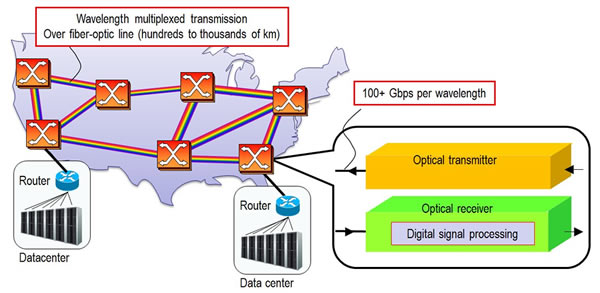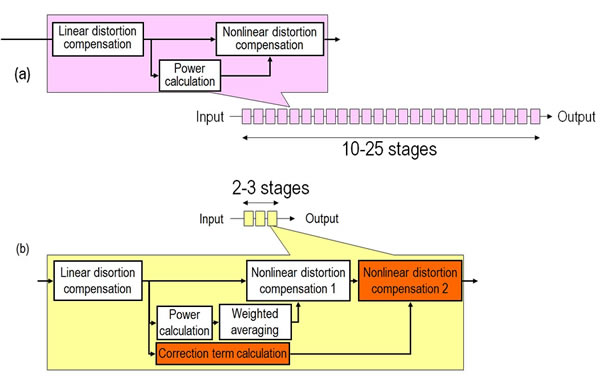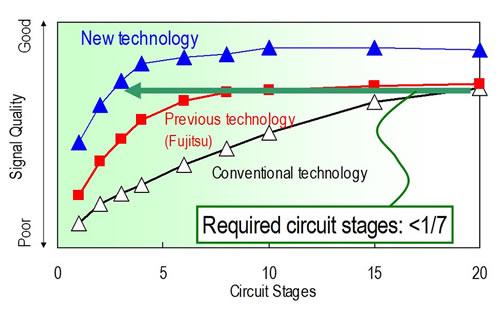Archived content
NOTE: this is an archived page and the content is likely to be out of date.
Fujitsu Develops High-Performance Distortion-Compensation Circuit, Enabling Compact and Energy-Efficient Ultra-High-Capacity Fiber-Optic Transmission Systems
Circuit size and energy requirements both reduced by approximately 85%, marking a big step forward toward performance boosting of ultrafast transmissions at 100 Gbps and beyond.
Fujitsu Limited,Fujitsu Laboratories Ltd.,Fujitsu Research and Development Center Co., Ltd.
Tokyo and Kawasaki, Japan, and Beijing, China, September 26, 2011
Fujitsu Limited, Fujitsu Laboratories Limited and Fujitsu Research and Development Center Co., Ltd. of China jointly announced their development of a digital signal processing algorithm to compensate for waveform distortions in signals transmitted by fiber-optic cables in long-haul transmission systems of 100 km or more. Compared to conventional technology in widespread use in literatures, the size and power requirements of the new circuit are reduced by approximately 85%, and are reduced by approximately 50% compared to circuits previously developed by Fujitsu(1).
For long-haul transmission systems that are used in the trunk-line networks of telecom carriers and networks that tie together large datacenters, the new circuit will enable ultrafast transmission systems operating at over 100 Gbps per wavelength to be more compact and consume less power than existing systems.
By enabling a tenfold or more increase in the capacity of networks, most of which now operate at 10 Gbps, the new circuits will usher in the ultrafast networks—able to handle extremely large volumes of data—that will underpin the next generation of smartphones and cloud services.
Some of this research was conducted as part of the "Universal Link Project R&D" sponsored by National Institute of Information and Communications Technology (NICT)(2), Japan. Details of this technology are being presented at the 37th European Conference and Exhibition on Optical Communication (ECOC2011), opening September 18 in Geneva.
Background
As the volume of data transmitted over the internet grows with the widespread use of smartphones and the development of cloud services, the trunk-line networks operated by telecom carriers and the networks that tie together large-scale datacenters are being called upon to carry more bandwidth at lower cost and greater efficiency. Wavelength division multiplexed (WDM) fiber-optic transmission systems that can carry 100 Gbps per wavelength—more than ten times existing levels—are expected to go into volume commercial deployment around 2012, and R&D efforts are progressing to enable continuous capacity increases in the future.
Technological Issues
When transferred over long distances of hundreds of kilometers by fiber-optic lines, ultrafast signals carrying data at speeds of 100 Gbps or more suffer from waveform distortion caused by nonlinear optical effects(3), making it difficult for the signal to be correctly received. This has prompted research into nonlinear compensation technology(4), which can restore the signal received with distortion to a clean waveform. Using conventional methods, however, the implementation of nonlinear compensation technology would require massive circuits with more than 100 million logic gates, and chips that include such compensation circuits are only expected to become feasible around 2020. Reducing the scale required of such circuits, therefore, has been a pressing issue.
In September of last year, Fujitsu developed a technology that would dramatically simplify these circuits, making them commercially viable as early as 2015. With the relentless growth in network traffic, however, ongoing improvements, in terms of circuits that are more compact and consume less electricity, are still needed.
 Figure 1. Ultrafast optical transmitters and receivers using digital signal processing in a trunk-line network.
Figure 1. Ultrafast optical transmitters and receivers using digital signal processing in a trunk-line network.
Larger View (73 KB)
Newly Developed Technology
The Fujitsu team has now developed a new signal-processing algorithm that, while retaining the distortion-correction performance of the technology developed last year, slashes the number of stages(5) required in a distortion-compensation processing circuit to about one-seventh current typical levels (and about half the level of Fujitsu's previous technology). Key features of this technology are as follows.
- Improved mathematical modeling for more accurate distortion compensation
As a result of approximation analysis, in which signal distortions are expressed as mathematical models, Fujitsu has been able to formulate distortion components that previous technologies have overlooked.
- Development of an efficient distortion-compensation circuit
Additional refinements to the above numerical modeling made it possible to develop an efficient design for accurate compensation, implemented in a small circuit. Adding this compensation circuit to the technology that Fujitsu developed in September last year resulted in a dramatic leap forward in the accuracy of distortion compensation and greatly reduced the number of circuit stages and overall size.
 Figure 2. Block diagrams of compensation circuits in conventional technology (a) and the new technology (b).
Figure 2. Block diagrams of compensation circuits in conventional technology (a) and the new technology (b).
Larger View (63 KB)
Results
In a transmission test at 112 Gbps over 1,500 km, the new technology was shown to achieve using a 3-stage circuit the same signal quality that conventional technology achieves using a 20-stage circuit, a reduction in required circuit stages of approximately 85% (see Figure 3). Because the circuit is much smaller in size, it also has greatly reduced power requirements. If the new technology were applied to the same number of circuit stages used in conventional technology, signal quality would be even higher, so it could also be used to extend transmission distances.
An ultrafast fiber-optic network using this technology could be built at lower cost, with lower energy demands. Such a network would enable the delivery of new services, which require the exchange of enormous data volumes that far exceed current levels, in the next generations of smartphones and cloud services.
 Figure 3. Relationship between signal quality and number of circuit stages for conventional technology (white triangles), Fujitsu's September 2010 technology (red squares), and the technology announced today (blue triangles).
Figure 3. Relationship between signal quality and number of circuit stages for conventional technology (white triangles), Fujitsu's September 2010 technology (red squares), and the technology announced today (blue triangles).
Larger View (72 KB)
Future Plans
This technology is expected to be used in the next generation of long-haul optical transmission systems running at speeds in excess of 100 Gbps that are on track for implementation by around 2015. The technology is also being studied for potential applications in high-capacity short-range networks, such as those used in datacenters and access networks.
About Fujitsu
Fujitsu is the leading Japanese information and communication technology (ICT) company offering a full range of technology products, solutions and services. Over 170,000 Fujitsu people support customers in more than 100 countries. We use our experience and the power of ICT to shape the future of society with our customers. Fujitsu Limited (TSE:6702) reported consolidated revenues of 4.5 trillion yen (US$55 billion) for the fiscal year ended March 31, 2011. For more information, please see http://www.fujitsu.com
About Fujitsu Laboratories
Founded in 1968 as a wholly owned subsidiary of Fujitsu Limited, Fujitsu Laboratories Limited is one of the premier research centers in the world. With a global network of laboratories in Japan, China, the United States and Europe, the organization conducts a wide range of basic and applied research in the areas of Next-generation Services, Computer Servers, Networks, Electronic Devices and Advanced Materials. For more information, please see: http://jp.fujitsu.com/labs/en.
About Fujitsu Research and Development Center
Established in 1998, Fujitsu Research and Development Center Co., Ltd. is a wholly owned R&D center of Fujitsu Limited, located in Beijing. The center's research areas cover the major business fields of the Fujitsu Group, including information processing, telecommunications, semiconductors, and software and services.For more information, please visit: http://cn.fujitsu.com/frdc/.
Press Contacts
Public and Investor Relations Division
Inquiries
Company:Fujitsu Limited
Technical Contacts
Photonics Lab
Network Systems Lab
 Phone: +81 (44) 754-2641
Phone: +81 (44) 754-2641
 E-mail: nlc@ml.labs.fujitsu.com
E-mail: nlc@ml.labs.fujitsu.com
Company:Fujitsu Laboratories Ltd.
All other company or product names mentioned herein are trademarks or registered trademarks of their respective owners. Information provided in this press release is accurate at time of publication and is subject to change without advance notice.
This press release has been revised as of December 17, 2018.
Date: 26 September, 2011
City: Tokyo and Kawasaki, Japan, and Beijing, China
Company:
Fujitsu Limited,
Fujitsu Laboratories Ltd.,
Fujitsu Research and Development Center Co., Ltd.,
,
,
,
,
,
,
,
![]() Phone: +81 (44) 754-2641
Phone: +81 (44) 754-2641![]() E-mail: nlc@ml.labs.fujitsu.com
E-mail: nlc@ml.labs.fujitsu.com

